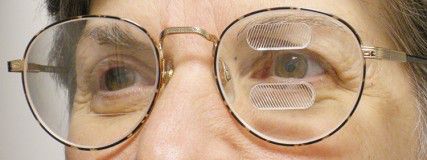Boston-based study shows majority of hemianopia patients prefer peripheral prism glasses to help them get around.

Imagine walking around and constantly stumbling over objects or accidentally running into walls and people. This might sound silly, but that is exactly what hemianopia patients experience on a daily basis.
However, to help ease the obstacles that hemianopia patients deal with regularly, Eli Peli, a professor of ophthalmology at Harvard Medical School, invented a device called peripheral prism glasses. In a study published in a Nov. 7 issue of JAMA Ophthalmology, researchers at the Schepens Eye Research Institute, including Peli, found that these glasses can be a simple and inexpensive rehabilitation tool for hemianopia patients.
Hemianopia, a condition that affects more than one million Americans and results from trauma, stroke or tumors, causes blindness in half of a patient’s visual field.
“Hemianopia is where you’ve lost half of the field of vision, so either the left half or the right half in both eyes,” explained Alex Bowers, one of the researchers and an assistant scientist at Massachusetts Eye and Ear Infirmary and the Schepens Institute. “If you’ve got left hemianopia and you look straight ahead, you’ll see absolutely nothing over on your left-hand side. It’s basically damage to the visual cortex.”
The glasses
Peli, who is also a senior scientist at Massachusetts Eye and Ear Infirmary and the Schepens Institute, said the idea came when he witnessed the struggle of his patients that suffered from severe vision loss.
“I was practicing low-vision care and every time a patient with this condition would walk into the room with visual field loss, it was really frustrating,” he said. “I couldn’t offer them much.”
So Peli decided to take matters into his own hands.
“I came up with this general idea of putting the prisms above and below,” Peli said. “I thought we could put higher power in the periphery.”
With high-powered prisms that expand visual fields as much as 30 degrees, these peripheral prism glasses essentially move objects from the blind side of the eye to the side where patients can see.
“If you look through them, you’ll see that it’s shifting stuff from the right over toward the left, so this would be for somebody with right hemianopia,” Bowers, who is also an assistant professor of ophthalmology at HMS, explained. “They shift objects from the blind side so that they are imaged on the seeing side.”
Bowers described the glasses as a “warning” for hemianopia patients. They signal that there is an object nearby, so patients must be aware. This signaling prevents patients from stumbling.
“When you walk around, something moves in your peripheral vision — you turn around and you look,” Bowers said. “But people with hemianopia don’t have that peripheral vision on that side, so they don’t know when they need to look over.”
Bowers recently led a multi-center study comparing real peripheral prism glasses with placebo peripheral prism glasses, which only shifted vision by about one or two degrees, to determine if peripheral prism glasses would appeal to hemianopia patients. It was determined that the majority of patients did in fact prefer the real glasses.
The study
In the study, hemianopia patients were recruited from several clinics and were told to wear two pairs of glasses: real peripheral prism glasses and fake peripheral prism glasses. However, patients were not initially aware that one pair was a sham. The glasses were simply labeled as “pair one” and “pair two.”
After four weeks of using the glasses, patients received a questionnaire to evaluate their glasses. Although the sham peripheral prism glasses looked similar to the real ones, they varied in prism power, which expanded the visual field by as much as 30 degrees for patients with the real prism glasses.
Earlier studies had shown that peripheral prism glasses had promise in helping patients get around efficiently, but the studies were mainly one-sided. They did not offer a comparison between other treatments or devices, such as sham glasses. These studies provided the basis for continuing research on peripheral prism glasses.
“The goal of the [recent] study was to continue to build the evidence base, but to specifically conduct a randomized-control trial,” Bowers said.
She said this study focused on the basis of having a control — something to compare the real glasses to the bogus ones.
“If you hadn’t had that sham prism glasses in there, but just had an open label study where everybody got real prism glasses, you wouldn’t be able to pick out those people who said ‘Yeah, I want to continue,’” Bowers said. “But they’re not actually getting any benefit from the glasses, so it’s really important to have a control condition.”
Casey Boutillier, a Sargent College of Health and Rehabilitation Sciences postgraduate physical therapy student, said she sees the study positively from an optical standpoint.
“As a physical therapy student, I know that not being able to see your entire visual field is very damaging, so it’s a great concept,” Boutillier said. “We know that patients who have in-tech motor learning can use these and can get better results with them and they can learn.”
The results
The study showed that the majority of hemianopia patients preferred the real peripheral prism glasses to the sham glasses. About 64 percent preferred the real glasses, compared to 36 percent who preferred the phony glasses.
Although this was the expected result, Bowers mentioned that the results for the sham glasses were still surprising, but sensible. This is because results were determined by individual preferences, rather than on actual benefits from the glasses.
“We were a little surprised to find as many as 36 [percent] preferred the sham over the real glasses — that’s an important finding,” Bowers said. “The reasons they selected those glasses were not for the benefit. They were because they were more comfortable, or in other words, they really didn’t do anything.”
Although some patients preferred the sham glasses, it was because the fakes were more comfortable, and not because they gave patients outstanding visual improvement, Bowers said.
According to the study published online in JAMA Ophthalmology, 41 percent of the hemianopia patients continued to wear the real peripheral prism glasses for the following six months.
Boutillier said she sees the glasses as a possible solution for hemianopia patients.
“It’s a good start, I think — it’s very promising,” she said. “We know that patients who have in-tech motor learning can use these, can get better results with them and can learn.”
Lemma Salem, a SAR sophomore, said she believes that exploring the social benefits of the glasses would also be useful.
“I know some people that don’t have hemianopia, but they have another disease where they eventually go blind when they’re older,” she said. “One of the main reasons why they probably invented this device is because people are bumping into walls or tripping over stuff. Another aspect of the study is social norms — I think that’s maybe one aspect they could discuss.”
The impacts
Both Peli and Bowers said the peripheral prism glasses are becoming widely accepted.
“It’s very hard to push anything new, but this is growing substantially,” Peli said. “I would see one or two hemianopes a year. Now half the people I see are hemianopes because I have something to offer them. They are coming from all over the city, the country, and the world even. Just having anything to offer is making an impact.”
Peli also mentioned the study has led to increased research on prisms and the implications they can have for hemianopia patients.
“We already published a paper and submitted another one this year on the prisms and the various effects of them,” he said. “And this is 12 or 13 years after we started. So there are still things to learn about that.”
Future insights
In terms of the study, there is hope to collect hard evidence and data on the prism glasses for the future and move away from the data collecting approach used previously.
“From a healthcare provider’s standpoint, I want to see more evidence that it’s not damaging to the rest of the vision beforehand,” Boutillier said. “But I think it’s great that they’re trying this.”
However, Elizabeth Kardas, a freshman in SAR, suggested that the glasses should be tested further in patients’ daily lives.
“I think they could take [the patients] outside of their homes and use [the glasses] in other places because that limits what they can do with them to see if it helps them in other ways in their life,” she said.
Salem said she hopes these glasses can become a gateway for future research regarding patients with hemianopia and other visually impairing conditions.
“This is a good device to help them with their day and with working,” she said. “I think for [the researchers] behind this, their next step is have it improve their vision without a device.”



















































































































